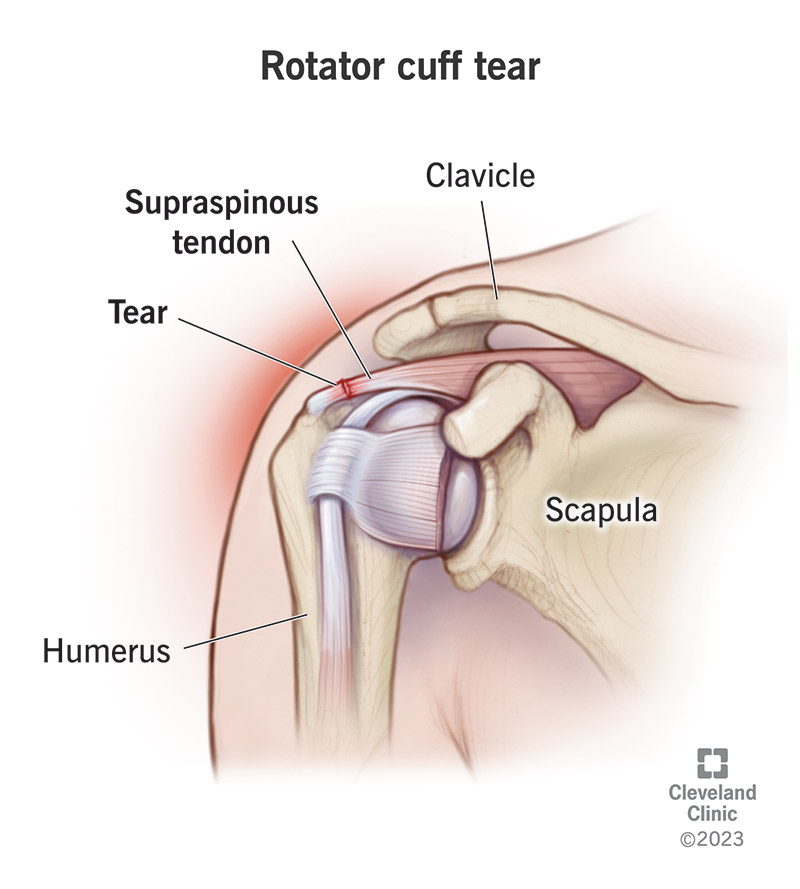A nurse in a provider's office is assessing a client who reports shoulder pain. Which of the following findings by the nurse indicates a rotator cuff injury?
Inability to abduct the arm at the shoulder.
Negative drop arm test.
Alteration in the contour of the joint.
A positive Tinel's sign.
The Correct Answer is A
Choice A reason:
The inability to abduct the arm at the shoulder is a classic sign of a rotator cuff injury. The rotator cuff is responsible for stabilizing the shoulder joint and aiding in various movements, including abduction. When there is a tear or significant weakness in the rotator cuff muscles, especially the supraspinatus muscle, the patient may be unable to lift the arm away from the body or may experience pain while doing so.
Choice B reason:
A negative drop arm test would actually indicate that there is no rotator cuff injury. The drop arm test is performed by asking the patient to fully abduct the arm to 90 degrees and then slowly lower it. If the patient can control the motion and lower the arm smoothly, the test is negative. A positive drop arm test, where the patient cannot control the descent of the arm, would suggest a rotator cuff tear.
Choice C reason:
While an alteration in the contour of the joint may indicate some form of shoulder pathology, it is not specific to a rotator cuff injury. Changes in the contour could be due to various conditions, including dislocation, arthritis, or other musculoskeletal disorders.
Choice D reason:
A positive Tinel's sign is used to diagnose nerve compression or nerve damage, not rotator cuff injuries. It is performed by tapping over the course of a nerve to elicit a tingling sensation or pain in the distribution of the nerve. This sign is commonly associated with conditions like carpal tunnel syndrome.

Nursing Test Bank
Naxlex Comprehensive Predictor Exams
Related Questions
Correct Answer is B
Explanation
Choice A reason:
While autoimmune disorders are associated with type 1 diabetes, where the immune system attacks the pancreas, they are not typically a direct risk factor for type 2 diabetes. Type 2 diabetes is more closely related to lifestyle factors and insulin resistance.
Choice B reason:
A 40-year-old client with hypoglycemia may be at risk for developing type 2 diabetes. Hypoglycemia can be a sign of pre-diabetes or insulin resistance, where the body's response to insulin is not as effective, leading to fluctuations in blood sugar levels. As individuals age, their risk for type 2 diabetes increases, particularly if they have other risk factors such as a sedentary lifestyle, overweight, or a family history of diabetes.
Choice C reason:
Lack of sleep can contribute to the development of type 2 diabetes by affecting the body's ability to regulate glucose and by increasing insulin resistance. However, without additional risk factors, it is not as strong a predictor of type 2 diabetes as the presence of hypoglycemia or other metabolic conditions.
Choice D reason:
Having never given birth is not a recognized risk factor for type 2 diabetes. While gestational diabetes is a risk factor for developing type 2 diabetes later in life, the absence of pregnancy does not increase the risk.
Correct Answer is D
Explanation
Choice A reason: Positive Trousseau's sign
Trousseau's sign is indicative of hypocalcemia, not CTS. It is elicited by inflating a blood pressure cuff on the upper arm to above systolic pressure for 3 minutes. A positive sign is characterized by carpal spasm, which is not related to CTS.
Choice B reason: Cool extremities
Cool extremities can be a result of various conditions, including peripheral vascular disease or hypothyroidism. They are not a specific indicator of CTS, which primarily affects nerve function rather than blood circulation or temperature regulation.
Choice C reason: Decreased radial pulse
A decreased radial pulse is not typically associated with CTS. It may indicate a cardiovascular issue or a blockage in the radial artery, which would require further investigation unrelated to CTS.
Choice D reason: Positive Phalen's sign
Phalen's sign is a diagnostic test for CTS. The test is performed by having the patient flex their wrist maximally and hold the position for about 60 seconds. A positive Phalen's sign, which includes numbness and tingling in the thumb, index finger, middle finger, and the radial half of the ring finger, is indicative of CTS. This occurs due to increased pressure on the median nerve when the wrist is in flexion.
Whether you are a student looking to ace your exams or a practicing nurse seeking to enhance your expertise , our nursing education contents will empower you with the confidence and competence to make a difference in the lives of patients and become a respected leader in the healthcare field.
Visit Naxlex, invest in your future and unlock endless possibilities with our unparalleled nursing education contents today
Report Wrong Answer on the Current Question
Do you disagree with the answer? If yes, what is your expected answer? Explain.
Kindly be descriptive with the issue you are facing.
